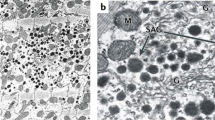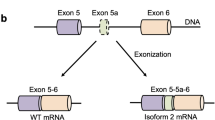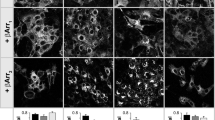Abstract
ALPHA atrial natriuretic peptide (α-ANP) and brain natriuretic peptide are homologous polypeptide hormones involved in the regulation of fluid and electrolyte homeostasis1,2. These two natriuretic peptides apparently share common receptors and stimulate the intracellular production of cyclic GMP as a second messenger1. Molecular cloning has defined two types of natriuretic peptide receptors: the ANP-C receptor of relative molecular mass (Mr) 60–70,000 (60–70 K), which is not coupled to cGMP production and may function in the clearance of ANP (refs 3,4) and the ANP-A receptor of Mr 120–140 K, which is a membrane form of guanylate cyclase in which ligand binding to the extracellular domain activates the cytoplasmic domain of the enzyme5,6. Here we report the cloning and expression of a second human natriuretic peptide-receptor guanylate cyclase, the ANP-B receptor. The ANP-B receptor is preferentially activated by porcine brain natriuretic peptide rather than human α-ANP, whereas the ANP-A receptor responds similarly to both natriuretic peptides. These observations may have important implications for our understanding of the central and peripheral control of cardiovascular homeostasis.
This is a preview of subscription content, access via your institution
Access options
Subscribe to this journal
Receive 51 print issues and online access
$199.00 per year
only $3.90 per issue
Buy this article
- Purchase on Springer Link
- Instant access to full article PDF
Prices may be subject to local taxes which are calculated during checkout
Similar content being viewed by others
References
Inagami, T. J. biol. Chem. 264, 3043–3046 (1989).
Baxter, J. D., Lewicki, J. A. & Gardner, D. G. Biol Technology 6, 529–546 (1988).
Fuller, F. et al. J. biol. Chem. 263, 9395–9401 (1988).
Maack, T. et al. Science 238, 675–678 (1987).
Lowe, D. G. et al. EMBO J. 8, 1377–1384 (1989).
Chinkers, M. et al. Nature 338, 78–83 (1989).
Von Heijne, G. Eur. J. Biochem. 133, 17–21 (1983).
Sabatini, D. D., Kreibich, G., Morimoto, T. & Adesnik, M. J. Cell Biol. 92, 1–22 (1982).
Singh, S. et al. Nature 334, 708–712 (1988).
Meloche, S., Ong, H. & DeLean, A. J. biol. Chem. 262, 10252–10258 (1987).
Meloche, S., McNicholl, N., Liu, B., Ong, H. & DeLean, A. Biochemistry 27, 8151–8158 (1988).
Holland, R., Woodgett, J. R. & Hardie, D. G. FEBS Lett. 154, 269–273 (1983).
Davis, R. J. & Czech, M. P. J. biol. Chem. 260, 2543–2551 (1985).
Kurose, H., Inagami, T. & Oi, M. FEBS Lett. 219, 375–379 (1987).
Song, D.-L., Kohse, K. P. & Murad, F. FEBS Lett. 232, 125–129 (1988).
Koesling, D. et al. FEBS Lett. 239, 29–34 (1988).
Krupinski, J. et al. Science 244, 1558–1564 (1989).
Kojima, M., Minamino, N., Kangawa, K. & Matsuo, H. Biochem. biophys. Res. Commun. 159, 1420–1426 (1989).
Pennica, D. et al. Science 236, 83–88 (1987).
Chen, E. Y. et al. Genomics 4, 479–497 (1989).
Ullrich, A. et al. Nature 313, 750–761 (1985).
Coussens, L. et al. Science 233, 859–866 (1986).
Peralta, E. et al. Science 236, 600–605 (1987).
Garbers, D. L. J. biol. Chem. 264, 9103–9106 (1989).
Saper, C. B. et al. Neurosci. Lett. 96, 29–34 (1989).
Light, D. B., Schweibert, E. M., Karlson, K. H. & Stanton, B. A. Science 243, 383–385 (1989).
Francis, S. H., Lincoln, T. M. & Corbin, J. D. J. biol. Chem. 255, 620–626 (1980).
Goldberg, N. D. & Haddox, M. K. A. Rev. Biochem. 46, 823–896 (1977).
Lawn, R. M., Fritsch, E. F., Parker, R. C., Blake, G. & Maniatis, T. Cell 15, 1157–1174 (1978).
Mullis, K. B. & Faloona, F. A. Meth. Enzymol. 155, 335–350 (1987).
Author information
Authors and Affiliations
Rights and permissions
About this article
Cite this article
Chang, Ms., Lowe, D., Lewis, M. et al. Differential activation by atrial and brain natriuretic peptides of two different receptor guanylate cyclases. Nature 341, 68–72 (1989). https://doi.org/10.1038/341068a0
Received:
Accepted:
Issue Date:
DOI: https://doi.org/10.1038/341068a0
This article is cited by
-
Cardiomyokines from the heart
Cellular and Molecular Life Sciences (2018)
-
Natriuretic peptide receptor-C activation attenuates angiotensin II-induced enhanced oxidative stress and hyperproliferation of aortic vascular smooth muscle cells
Molecular and Cellular Biochemistry (2018)
-
Pharmacogenomics of the Natriuretic Peptide System in Heart Failure
Current Heart Failure Reports (2017)
-
cGMP Signalling Mediates Water Sensation (Hydrosensation) and Hydrotaxis in Caenorhabditis elegans
Scientific Reports (2016)
-
Delineating a New Class of Membrane-Bound Guanylate Cyclases
Springer Science Reviews (2016)
Comments
By submitting a comment you agree to abide by our Terms and Community Guidelines. If you find something abusive or that does not comply with our terms or guidelines please flag it as inappropriate.



